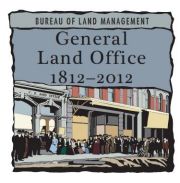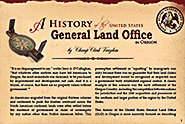General Land Office 200 Year Anniversary

The Bureau of Land Management was officially established in 1946, but it has roots dating back two hundred years, since the foundation of the General Land Office (GLO) in 1812. The "Gateway to Land Ownership" as it was colloquially dubbed, helped millions of Americans in the 19th and 20th centuries acquire public lands for private and agricultural usage, while simultaneously generating income for the Federal Government.
In April 2012, the GLO celebrated its 200th birthday! The BLM Oregon/Washington invites you to learn more about our historic lands and the enduring legacy of the General Land Office.
History of the GLO in Oregon
BLM is proud to announce the release of this new book that provides an in-depth look at Oregon's history through the eyes of the General Land Office. In 1812, the General Land Office or GLO was established as a federal agency within the Department of the Treasury. The GLO's primary responsibility was to oversee the survey and sale of lands deemed by the newly formed United States as "public domain" lands. The GLO was eventually transferred to the Department of the Interior in 1849 where it would remain for the next ninety-seven years. The GLO is an integral piece in the mosaic of Oregon's history.
Today the imprint of the GLO on Oregon's landscape is unmistakable in its cardinally-oriented roads and property lines. However, the story of the GLO in Oregon runs deeper than mapping and surveying the lands. As agents of the United States, GLO surveyors operated under the umbrella of United States' public land laws and policies and treaty-making with Indian tribes. This free book is just a small, but fascinating piece of Oregon's history and the role played by the GLO! Download your free copy here (PDF).
Interview with GLO Book Author Champ Vaughan

Several years ago, retired BLM employee, Champ Vaughan, went back to his roots and began work on the recently released book A History of the United States General Land Office in Oregon. Of course, behind every great book is a great author... and a great story. In this short interview Champ shares his experiences and thoughts about writing and investigating some of the elements that make Oregon what it is today—the General Land Office! Click here to read this short interview with author Champ Vaughan.
Click here to read this short interview with author Champ Vaughan.
Tell us a little about yourself and the role(s) you previously held with the BLM.
I majored in Geography in college. After a tour of active duty with the U.S. Air Force, I was employed as a geographer with the Interior Department in Washington, D.C. My career with the BLM was primarily within the Oregon/Washington State Office. I had work details to all of the BLM districts in Oregon and Washington and frequent staff details to the BLM Headquarters in Washington, D.C. Primary assignments included Lands and Realty, Withdrawal Review Coordinator, Supervisory Geographer, Supervisory Land Law Examiner, and Lands and Minerals Adjudication Program Manager.
How long did you work for the BLM and where did you get your start?
In 1966, I began my career with the BLM in the land office of the Oregon/Washington State Office and retired in 1993 after 31 years of federal service.
When did you decide to write "A History of the United States General Land Office in Oregon?"
I was fascinated with the history of BLM's predecessor, the GLO, and I saw the need for a comprehensive reference book for BLM employees and the general public. Long before I retired from the BLM, I decided to eventually write a history of the GLO in Oregon. I collected copies of various historical maps, documents, publications, etc., which I could use as source materials later. I actually began to write my manuscript in 2009.
As you wrote the book, did you learn anything about the GLO or the BLM that you didn't previously know?
It is said that one never stops learning. My research for the book introduced me to a wide range of facts and information that I was not completely aware of. I learned that the contrasting perspectives of the federal government, pioneer immigrant settlers, and Native American tribes, concerning the public domain in Oregon, were a very significant part of the GLO history.
If you were at a party and someone asked you about this history, how would you describe it in on sentence?
The book is a comprehensive and retrospective account of the history of the public lands in Oregon.
What do you think has been the biggest change to the GLO and BLM since 1812?
The biggest change was the federal government's policy of disposing of the lands to private and state ownership, which gradually changed into a policy of retention in federal ownership for multiple-use management and conservation of natural resources.
What is the BLM and Interior doing the same 202 years later?
Although public land management policies have changed, the vast United States Public Land Survey System and the public land status records continue to be the solid foundation upon which rests title to all land that is now, or was once, part of the public domain.
What's your favorite BLM spot, or GLO historic site to visit in Oregon/Washington?
My favorite spots to visit are the Steens Mountain Wilderness Area in the Burns District and the Cape Disappointment Lighthouse Reserve, the first formal land withdrawal and reservation established in the Oregon Territory, on land now within the state of Washington.
If you had a chance to write another book, what would the focus of that yet-to-be written book be?
I would like to write a book on the historical geography of Oregon or on the historical geography of a specific county within Oregon, such as Clackamas County.
Commemorating 200 Years of the General Land Office
Two hundred years ago, the General Land Office (GLO) opened its doors for business. Today that "land office business" continues at the Bureau of Land Management-Eastern States Office, which will commemorate the occasion with events scheduled throughout the year.
- National BLM GLO Website
- GLO to the BLM timeline
- GLO Gallery
- GLO Records
- Historic GLO Photos
- BLM Revisits Old West (Historic GLO photos)
- Homestead Act 150 Year Anniversary
- GLO Fact Sheet (PDF)
Today's General Land Office
View a brief tour of the GLO at BLM's Eastern States Office, including the fireproof vault, document scanning, and bindery.

